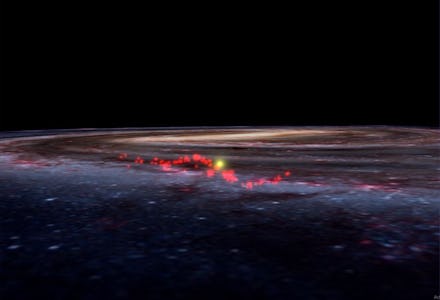This mysterious wave of star-forming gas might be the biggest thing in the galaxy

There are several very large things within the galaxy, with supermassive black holes taking the cake as far as modern research is concerned. But according to new research published in the scientific journal Nature, there's something much bigger out there, just chilling in the Milky Way: a stream of gas and stars affectionately titled the "Radcliffe Wave." Named after Harvard's Radcliffe Institute for Advanced Study, where much of the research surrounding the construct was performed, it's a massive and confounding structure.
Beginning at the constellation Orion and stretching around 9,000 light-years (a whopping 9% of the galaxy's diameter in whole), it's a dizzyingly colossal object that includes around 800 million stars and active star-forming gas. The Radcliffe Wave continues to wrap around constellations like Taurus and Perseus, peaking around Cepheus, and wrapping around again. According to study co-author João Alves, it's the final word on huge objects in our galaxy.
"What we've observed is the largest coherent gas structure we know of in the galaxy," said the University of Vienna's Alves in a statement. "The sun lies only 500 light-years from the wave at its closest point. It's been right in front of our eyes all the time, but we couldn't see it until now."
Alves and his team ended up bringing the Radcliffe Wave to light by using a special 3D map of the Milky Way using data from the European Space Agency's Gaia satellite. After noticing an odd pattern of gas and stars around Orion, they decided to investigate closer. They took a look at the Gould Belt (which was discovered about a century ago) around the same area and found some intriguing developments.
Previously, scientists had assumed the Gould Belt was simple a circle of gas that could potentially form stars, with the Sun at the center. But after Alves and his team delved into the data gleaned from the Gaia satellite, they found something much different. The Gould Belt is simply one small part of the Radcliffe Wave, and there is no circular shape to the Belt at all, rather, all of it wraps in and out of our solar system.
"We don't know what causes this shape but it could be like a ripple in a pond, as if something extraordinarily massive landed in our galaxy," Alves said. "What we do know is that our sun interacts with this structure."
It's not immediately clear what brought the Radcliffe Wave into being, though researchers estimate that it could be about 13 million years old – that's apparently when the solar system ended up becoming entangled with it. Apparently, another 13 million years from now, the same thing could happen again.
But by then, obviously none of us will know if another "wave" rolled in. Hopefully as the years go by, we'll have a bit more insight into where the wave originated, why it's there, and how it got so massive. For now, as with all large objects, it's probably our best move to sit back and admire.